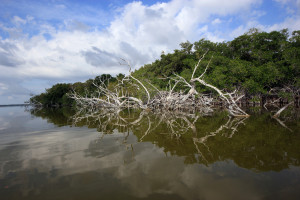 The Everglades is a federally-protected National Park home to thousands of plants, wildlife, aquatic life, and more. It has a diverse ecosystem and has many species not found anywhere else on the planet. There are nine habitats in the Everglades. We wanted to share with you a little information about each habitat you can find in the Park.
The Everglades is a federally-protected National Park home to thousands of plants, wildlife, aquatic life, and more. It has a diverse ecosystem and has many species not found anywhere else on the planet. There are nine habitats in the Everglades. We wanted to share with you a little information about each habitat you can find in the Park.
Freshwater slough
Sloughs are mainly responsible for the water circulation throughout the Everglades. Sloughs are flooded, sunken areas of land that distribute freshwater to other areas of the ecosystem. There are two sloughs in Everglades National Park: Taylor Slough and the Shark River Slough, also known as the “River of Grass.” Both sloughs ensure freshwater reaches the Florida Bay. Because of freshwater, sloughs are popular wildlife congregation sites. If you visit the Everglades sloughs in the dry season (November through May), you will have the best chance to spot alligators.
Hardwood hammock
Hardwood hammocks are dry, slightly elevated concentrations of tropical and temperate trees with broad leaves. Hardwood hammock habitats rarely flood. The trees grow close together, creating overhead canopies with shade from the sun. Hardwood hammocks are home to the red-limbed Gumbo Limbo tree, ferns, mahogany, oak, maple and more.
Pinelands
Pineland habitats also grow on higher ground. Also known as the Pine Rocklands, skinny slash pine trees grow tall out of a hard limestone surface. Around the trees’ roots thrive various species of palm, from the adequately named saw palmetto to the edible sable palm. Believe it or not, pinelands rely heavily on fire for survival. Over the years, pineland trees adapted to fires by acquiring thick bark and growing needles only where the fire can’t reach.
Coastal lowlands
This habitat is great for the most resilient flora. Found near the shore of the Gulf Coast, coastal lowlands are used to severe weather, which restricts the growth of mangroves and other tall trees. Desert plants usually survive in coastal lowlands because they can withstand harsh storms without much protection. At the sandy lowlands you’ll see short, salt-tolerant shrubs like succulents.
Mangroves
The Everglades has the most abundant population of mangroves in the entire hemisphere. Mangroves thrive where freshwater and saltwater meet. These salt-tolerant mangrove trees come in three colors: red, white and black, all of which nurture plant and water life. Mangrove habitats provide essential nutrients to marine animals by depositing fallen leaves into the water.
Cypress
These towering trees can grow in standing water or in breaks in the hard ground. When the limestone surface of a pineland habitat breaks, it gives way to “solution holes.” Often clusters of cypress trees grow inside these weathered pits, with the larger trees concentrated in the center. River otters often lounge on low-lying cypress trunks. Another popular inhabitant of cypress swamps is the American Alligator.
Marine and estuarine
Florida Bay is the Everglades’ largest water body. Freshwater from Everglades estuaries mixes with saltwater from the Gulf of Mexico to create the brackish conditions in Florida Bay. Towards the bottom of the bay you’ll find coral, mollusks and a plethora of gamefish. Closer to the surface, bottlenose dolphins swim in pods, loggerhead turtles coast leisurely, and West Indian Manatees float with their young.
You can see a glimpse of many of these habitats while on an airboat tour. Airboats are a safe way to explore the Park and see areas you may not get to on foot.
For a private, guided tour through Everglades, book an airboat tour with Captain Mitch’s Airboat Tours.
To book an airboat ride, call 800-368-0065 or visit our Private Everglades Airboat Tours page. We are open seven days a week 8:30 a.m. to 5 p.m. If paying by cash, adults cost $40 (plus tax) and children 12 and under cost $20 (plus tax. If paying by credit card, adults cost $45 (plus tax) and children cost $25 (plus tax).






